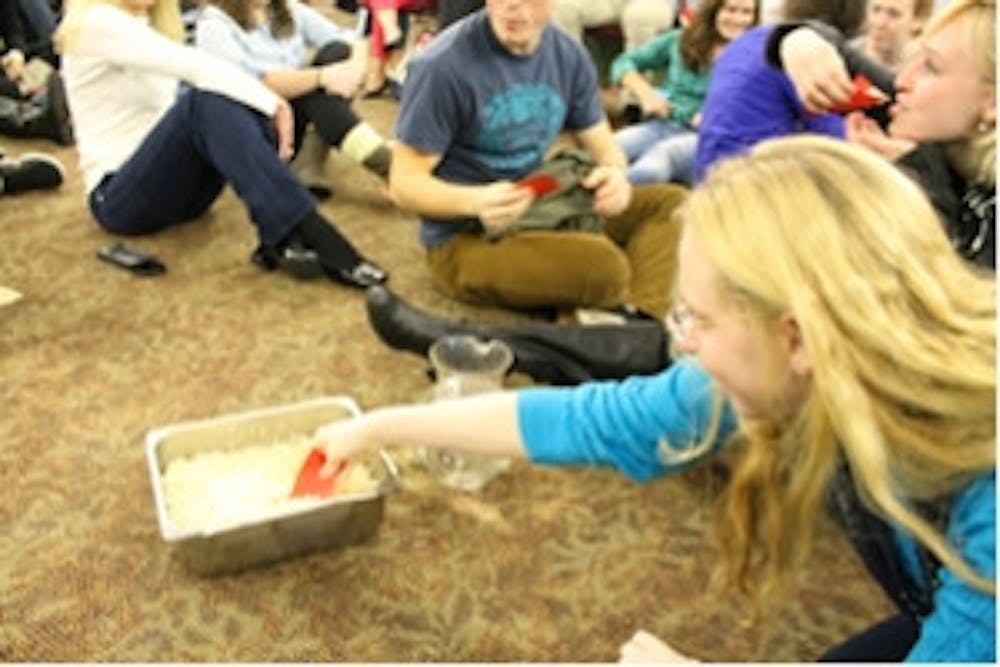
As guests enter the Multi-Purpose Room at Miami University’s Shriver Center for the Oxfam Hunger Banquet, they are promptly asked to blindly pick a card out of the basket.
Based on they card they draw, they are assigned an identity for the evening. The socio-economic status of that identity determines their seat for the meal. Which may be on the floor, with no utensils and a pot of rice to share.
“This event is a metaphor for how food and other resources are inequitably distributed across the world,” says Briana Deer, co-president of Oxfam’s Miami chapter, as she welcomes guests to the banquet Nov. 6.
Oxfam is an international organization working in 90 countries worldwide to end hunger, poverty and injustice. The Hunger Banquet is an annual way for the Miami chapter to raise awareness for its mission.
“At Miami, people think ‘hunger and poverty doesn’t affect me’ because we don’t see it,” says Deer, a sophomore zoology major. “You go to other places and it’s so obvious. We just want others to know that people so similar to you are suffering; you were just born into a difference circumstance.”
About 870 million people go hungry annually worldwide, according to the United Nations’ Food and Agriculture Organization. At a national level, 14.5 percent of American households had a less-than-ample food supply, according to 2010 federal data, the most recent available.
About 15.1 percent of Americans fall below the poverty line. But as close as Hamilton, Ohio – just 14 miles from Oxford – some 21 percent live in poverty, U.S. Census data shows.
Before the meal is served this night, Deer and other Oxfam officers discuss aspects of poverty, hunger and injustice with attendees.
Then, as the event progresses, several attendees are instructed to move from their seat to another. This is meant to represent real people suffering life’s inevitable circumstances and falling from economic comfort.
Sophomore Rachael Osborne, one of the attendees whose “character” suffered an economic blow, describes the simulation as a “very accurate depiction of how easy it is to slip from middle class to poverty in the blink of an eye.”
Ten guests represent “high-income” earners, or people who make at least $6,300 per year or equivalent global wages. At a beautifully set table, waiters fill their glasses with water and juice, and serve them bread with butter, a fresh salad, and chicken with rice. Their balanced meal is presented on china with silver utensils.
Fifteen guests are invited to sit on one of the chairs lined in a row. They represent “middle-income” earners of $1,128 to $6,300, or equivalent global wages, a year, and they must serve themselves rice and beans on paper plates from a buffet, drinking water from plastic cups.
The remaining 25 people at the dinner are the “lower-income” earners of less than $1,128 a year, and they sit on the ground. A vat of rice and pitcher of water are placed before them. No cups or utensils are given to them.
“It really changed my perspective,” says attendee Matt Dunn. “Our idea of the lower class is higher than most of the world’s middle class.”
As in life, it is a simple card a guest is dealt at the beginning that determines their circumstance.
As the meal progresses, the “higher income” earners eat in silence, avoiding eye contact with each other and with the “lower classes.” The “middle-income” earners are slightly more sociable. But the most interaction occurs among the group on the floor, who chat, laugh and collaborate to divvy up the rice and water.
“It just felt really awkward,” says Erin Bergmann, a junior zoology major who won a spot at the high-income table by luck of the draw. “I wanted to help the other people, but didn’t know what to do.”
One middle-income participant broke the barrier between the classes by donating her plate and cup to the group on the floor.
“I’ve travelled to Ecuador and Peru and seen truly hungry people in real life,” explains Taylor Hendricks, a senior exercise science major. “I gave them my food then, and I would do it again.”
In Oxford, the Oxford Community Choice pantry has similar values of helping those in need. Dedicated to providing sustainable food to those in need, the pantry has been providing impoverished families with nutritional groceries free of charge since 2007.
Haley Mullins, a sophomore business economics major and co-president of Oxfam, emphasizes the necessity of people helping one another.
“Eliminate injustice, and you can eliminate hunger,” says Mullins. “Everyone has the same basic needs; it is only our circumstances that differ.”
Written by: Chelsea Liebenthal
